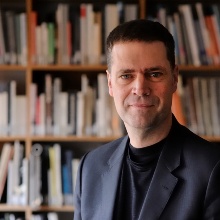Do buildings need to be permanent? What can architecture look like which adapts to the social changes of the future? And how can we build in a way which is carbon neutral? Professor Martin Ostermann at the Institute for Building Technology, Construction and Design is getting to grips with these questions. The architect has been lecturing at the University of Stuttgart since the winter semester 2018/19. “My research focuses on two main areas, adaptive architecture and new materials. These are determined by changes in society and our increasingly changing climate”, is how Ostermann describes his work at the Institute für Baukonstruktion (IBK2). As a “participating researcher”, the chair is a part of the Cluster of Excellence "Integrative Computational Design and Construction for Architecture": A new way of thinking for the built environment.
The 50-year-old studied architecture at the RWTH Aachen University, the Bartlett School of Architecture and the Architectural Association in London. After graduating, Ostermann spent six years working at the Studio Daniel Libeskind in Berlin, where he managed a number of projects. In 2005, he founded the architecture firm magma architecture together with a partner. One large project carried out by the Berlin-based firm was the complex for the Olympic and Paralympic shooting events at the 2012 Olympics in London. What was special about it was that in 2014, parts of it were transported to Glasgow and reused in the Commonwealth Games. “We’re very proud of that, because sustainable construction is very important to us.”
Ostermann also spends a lot of time grappling with the effects of climate change on architecture at the Institute. Adaptive architecture plays an important part in this. “My research into adaptive architecture is not just aimed at parts of the building but adapting entire buildings.” It’s a question of developing concepts and the built environment in an era when the climate is changing. One idea for example is to design buildings in such a way that they can be moved inland from the coast in response to rising sea levels.
Digital design, the use of computer-generated production processes as well as 3D printing opens up new pathways and opportunities.
Prof. Martin Ostermann
Adaptive architecture also plays a central role in Ostermann’s teaching. The architect has previously taught at universities in Gothenburg, Sydney, Perth and Oman, meaning he has had experience in dealing with the subject all over the world. Ostermann is also working on an adaptive design project at the University of Stuttgart together with students. “We’re designing a building which will be on show in two different places. It’s a pavilion for the Expo 2020 fair in Dubai, which will then later be transported to Stuttgart.” An Arabian desert and a German city – the pavilion has to be adapted to the conditions in each place.
Right from the planning stage, integrating this capacity for change is a real challenge. In the meantime, digital fabrication has had an impact on Ostermann’s entire field of research. “Digital design, the use of computer-generated production processes as well as 3D printing opens up new pathways and opportunities for us.”
New materials as a focus of research
Ostermann’s second focus of research is new materials. This is about developing sustainable, renewable and carbon-neutral materials alongside the concrete, masonry, steel and wood which have previously been used. This is because sand, which is required in the manufacturing of concrete, has now become scarce. “And the production of cement causes more CO2 emissions than all air traffic around the world put together. This is why we’re conducting research into bio-based materials, lightweight materials and multiple property materials”. The term “multiple property materials” (MPM), which he coined himself, is used to mean a material which combines multiple properties, such as for example static properties, insulation, acoustic insulation and weather protection. Materials are often used in construction which have separate individual characteristics. This results in different materials being blended together, which are disposed of together and can no longer be recycled.
In the next few weeks, a research laboratory will be set up which will make it possible for students and scientists to carry out research into new materials and consider the shell, the façade and the construction all together. “Our specific aim is to find alternatives to concrete”, explains Ostermann. The main objective is to find solutions for how architecture should respond to the new climatic and societal conditions.
The architect himself remarks on how changes in society have an influence on architecture. “My family now lives in Berlin and my son goes to school there, which is why I commute at the moment. We don’t know yet if and when we’ll be moving to Stuttgart.” He says commuting hasn’t been a problem so far. “The increase in mobility and the changing nature of work ultimately has an impact on my work as an architect. For example, hardly anybody uses isolated individual offices any more, it’s integrative, flexible and modifiable solutions that people are looking for these days.”





